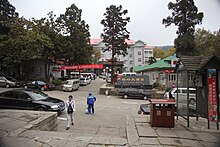Lushan (Jiujiang)
Lushan ( Chinese 庐山市 , pinyin Lushan Shì until 2016, the county Xingzi, 星子县 , Xīngzǐ Xiàn ) is a county-level city in the administrative area of the prefecture-level city of Jiujiang in the south Chinese province of Jiangxi . It has an area of 734 km² and has 230,000 inhabitants. Its seat is the large community of Nankang (南康 镇).
The Guanyin Bridge (Guanyin qiao 观音桥), the first bridge over the southern Yangtze from the Song Dynasty , the Academy of the White Deer Grotto or "Bailudong Academy" and the Xiufeng rock inscriptions (Xiufeng moya 秀峰 摩崖) are on the list of monuments of the People's Republic of China .
Administrative structure
At the community level, Lushan consists of nine large communities and one community, as well as a farm and an administrative area office. These are:
- Greater community Nankang (南康镇)
- Greater community guling (牯岭镇)
- Greater community Haihui (牯岭镇)
- Greater community Bailu (白鹿镇)
- Wenquan Municipality (温泉 镇)
- Xingzi Municipality (星子 镇)
- Greater community Hualin (华林镇)
- Greater community Jiaotang (蛟塘镇)
- Greater community Hengtang横塘镇
- Community Liaonan (蓼南乡)
- Mountain forestry Dongpu (东 牯 山林 场)
- Shahushan Administrative Office (沙湖 山 管理 处)
Lushan Landscape Park
In the area of the city is the Lushan Landscape Park (庐山 风景区) with the famous Lu Shan Mountains . The park has an area of 302 km², of which 282 km² is pure mountain area. Highest peak, high above the river Jangtsekiang Hanyang Feng (汉阳峰) is 1474 m . It is also popularly referred to as Da Hanyang (Great Hanyang), although it is not officially called that. The Lushan offers landscapes of breathtaking beauty. The Lushan Mountains have long been described by poets. It is also the origin of Chinese landscape painting. The seat of the park administration and tourist center is the large community of Guling (literally: Bull Mountains).
Guling
This small mountain community has an area of 46.6 km² and a population of 13,000 (end of 2004). It is 1167 m high. Uninformed western tourists like to confuse Guling with Lushan, as the name of the landscape park or the city district dominates the public image and the other municipalities are not of great tourist importance.
At the end of the 19th century, the European colonial rulers made Guling a summer vacation spot. In slightly modified English pronunciation, the place was called Cooling , which corresponded to its main function during the summer. Even then, bamboo and pine trees, waterfalls and mossy stones offered a welcome change from the humid heat of the lowlands. Built by Europeans, around 800 villas were built in different styles. American and Chinese villas were added later.
In the first half of the twentieth century Guling was the summer capital of Chiang Kai-shek for 13 years , who resided with his wife Song Meiling in their house built by Europeans, the Villa Meilu (美 庐 别墅, literally: "Beautiful Lushan"). The villa is now a small museum, in which the old grand piano, furniture and porcelain dishes from Chiang's and Song's times can be viewed.
After the founding of the People's Republic, Guling was also a preferred resort for the party leadership. In 1959 , 1961 and 1970 important conferences of the Central Committee of the Communist Party of China took place here in the presence of Mao , the famous Lushan meetings. The venue was the “Great Lushan Festival Hall” ( Lushan Dalitang庐山 大礼堂), one of the three buildings that Chiang had built in 1937 for his officer training regiment. Today the house serves as a museum ( Lushan Huiyi Jinianguan庐山 会议 纪念馆) to commemorate the three Lushan conferences.
Mao, who initially stayed at Villa Meilu during the Lushan Conference, had his own residence built in Guling in 1961, directly on the shores of Lake Lulin, Villa Lulin (芦林 别墅), also known as “Lulin No. 1 "known. The architecture combines Chinese and Western elements. In 1984 the 2,700 m² building (with inner courtyard) was converted into a museum, which shows various items from the inventory of the above 800 villas, as well as historically significant objects and works of art. Of particular note are the portraits of the 500 arhats (五百 des 图) by the Qing- era painter Xu Conglong ( ong sind龙). He had worked on the monumental work, which consisted of 200 individual pictures, for six years. In the chaos of the war and civil war, 88 sheets were lost, so that 112 can still be seen today. Another focus is on ceramics and porcelains from the Han to the Qing period, with a certain focus on Ming and Qing porcelains.
Today Guling is accessible to all sections of the population. Many wealthy people who can afford it buy summer residences here. The local authorities are keen to position the larger community as a renowned tourist destination for well-heeled guests from all over the country, but also from Japan, the USA and Europe.
Web links
Coordinates: 29 ° 22 ′ N , 115 ° 57 ′ E





